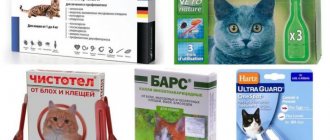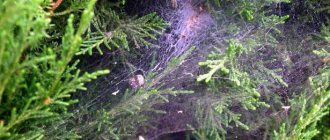Why does dirt appear in a cat's ears?
If your cat is healthy, earwax will have a yellowish or slightly brown tint. Very little of it is released to protect against the penetration of fungi, bacteria and insects.
The process of sulfur formation is individual and depends on many factors: living conditions, nutrition, breed. Some representatives of the cat's ears get dirty often, while others require cleaning once every six months.
A healthy cat's ear should not become dirty quickly. If after cleaning, after 3-4 days, plaque forms, there is discharge, and an unpleasant odor is a reason to consult a veterinarian.
If dark, black plaque or dirt is detected, action must be taken - this is the first sign of otodectosis - ear mites. In this case, the plaque may be in the form of flakes or similar to ground coffee. The presence of liquid discharge of any color in the ear canal indicates the onset of otitis media.
Cleaning Frequency
Healthy cats' ears clean themselves. Sulfur is released to the surface when chewing. Plus, the animal itself removes its excess with its paw while washing, shaking its head. But some cats have a lot of discharge, and the owner must help the pet.
To understand when it's time to clean your cat's ears, you need to conduct periodic inspections. It is better to do this in good lighting. This makes it easier to determine the type of plaque and the condition of the auricle. Animals walking on the street are examined daily in order to promptly detect the presence of a foreign body.
On average, a cat needs ear cleaning 1-2 times a month, for some cats no more than 2 times a year. Therefore, how often to carry out a hygiene procedure is determined strictly individually and according to the degree of contamination. Too frequent cleaning is unsafe, since along with the sulfur its protective properties disappear.
Caring for show cats is more thorough. Cleansing is carried out on a regular basis. It is impossible to win with dirty ears.
Cats with floppy ears and no hair need ear cleaning more often. It is believed that the shell of fold-eared cats, due to its structure, does not clean itself, and the animals are more often susceptible to ear diseases.
What is needed for the procedure
To clean a cat's ears at home, you need not only a certain skill, but also specific equipment . For this procedure you will need:
- Cotton pads . With their help, the auricle is freed from dust and dirt before cleaning.
- Cotton buds.
- Ear cleansers . To treat the ears, disinfectants are used, for example, chlorhexidine solution, hydrogen peroxide, 3% boric acid solution. You can also use special solutions for caring for the ears: Rosinka, Otoklin, Bars. Thanks to such products, dirt and sulfur deposits are effectively dissolved without irritating the animal’s skin.
In addition, you may need a towel. If the cat is not accustomed to such a procedure, then it can be wrapped in a blanket, blanket or towel to avoid injury during the procedure. Aids include a small flashlight for good lighting and a treat to encourage the cat during the procedure.
How to properly clean a cat's ears
Technique on how to clean a cat’s ears at home for the purpose of prevention:
- Place the cat on your lap. If it resists, fix it with a towel, leaving only the head free. It is important to calm the cat down and speak to him in a gentle voice.
- Carefully unfold the auricle. This will not cause the cat any discomfort and will not hurt him.
- It is difficult to remove completely dry dirt. To treat the auricle and canal, use a special spray that softens the wax. You need to choose a neutral lotion that does not contain medicinal substances. You can clean it with Vaseline or olive oil, saline solution. The most budget option is warm boiled water. Often water cannot be used, because... The skin may deteriorate.
- Moisten a cotton pad (preferably without stitched edges) and gently insert it into your ear with your finger.
- Pass the disc without pressing along the inside of the ear. A separate disc is used for each ear to avoid accidentally spreading infection.
- If the surface is wet, wipe with a dry swab or towel.
There are hard-to-reach places in the ear - folds, from where wax and dirt are removed with a cotton swab, also soaked in the solution.
However, veterinarians do not recommend cleaning the ear canal with a cotton swab at home. The ear canal of cats is curved. There is a great risk of pushing the contents deep into the canal and damaging the eardrum. If you decide to use cotton swabs, you must act carefully. All movements should be directed outward.
Ear cleaning procedure
Before starting the procedure, prepare everything you need.
The upper part of the ear is cleaned with a cotton sponge or neutral wet wipes.
For the lower one, it is advisable to use children's cotton swabs with limiters - this way there is less risk of injuring the animal. You need from 2 to 4 of them for each ear, depending on the degree of contamination. You should not use the same stick for different ears, even if it seemed to remain clean.
Prepare enough blades and chopsticks so that you don't have to take a break because you don't have enough.
Do not use homemade matchsticks - the cotton wool can easily slip off and remain in the ear. In addition, in this case there is a high risk of scratching the animal.
Some experts do not recommend using sticks at all, noting that there is a risk of only pushing the sulfur deeper. Instead, they suggest pouring in the cleanser one at a time for several days in a row until the stains are gone.
If possible, prepare a small flashlight - it will allow you to better examine the auricle. If necessary, warm the cleanser to room temperature.
It is best to carry out cleaning when the cat comes on its own and asks for attention or is half asleep. During the procedure, talk quietly and gently to your pet to calm him down.
How to clean a cat's ears:
- Place your pet on a table or in your arms. If he is calm about the procedure, you can simply hold him with your hand; if he breaks out, carefully swaddle him in a towel or call an assistant.
- Gently turn the ear outward - this is not painful and will not harm the animal. With fold-eared cats, as well as those with curled ears, for example, curls and lefties, you need to act especially carefully. Carefully examine the ears for symptoms of disease.
- Place 5-7 drops of lotion or saline solution into your ear - the manufacturer should indicate the exact dose. For kittens, 2-3 drops are enough. Gently massage the base of your ear for a minute.
- Allow the cat to shake its head and shake the liquid and loosened dirt out of the ears. For light contamination this is sufficient.
- If the ear is heavily soiled, wipe the upper part of the ear with a sponge and clean the lower part with a cotton swab. It can be immersed to a depth of up to a centimeter, for kittens - half a centimeter. Don't be afraid to pierce your eardrum - this is impossible due to the curves of the auricle, although you still need to act carefully. Move the wand outward rather than inward to remove dirt rather than push it deeper.
- After cleaning is complete, praise and pet the animal and reward it with a treat.
Accustoming kittens to the procedure
It is very important to teach your pet to calmly endure the ear cleaning procedure, otherwise in the future, by struggling and resisting, he will complicate the owner’s task, and besides, by jerking at the wrong moment, he can seriously harm himself.
It is advisable to play with the baby in advance so that he gets tired and calms down. It’s not worth interrupting the game in the midst of it - the kitten will be too excited and will probably resist, and the procedure in this case will cause unpleasant associations for it.
An animal accustomed to the procedure from childhood most often perceives it calmly.
Stroke the prepared animal, talk softly and affectionately to it to calm it down. If the kitten still resists touching its ears, you can restrain it by carefully wrapping it in a towel. Please note that you cannot express your dissatisfaction with the animal or scold it, much less act rudely. Even when swaddling a kitten, speak in a friendly manner. Praise him in moments of calm and obedience.
After completing the cleaning, be sure to give the kitten a treat and, if he wants, play with him - the procedure should be associated with pleasure.
The attitude towards ear cleaning largely depends on the character of the animal. Our first cat never struggled or showed aggression during the procedure; he only pressed his ears to his head with force, so it took some effort to straighten them. Since at the same time he usually sat quietly next to her, without trying to escape, it seemed that he saw this as a kind of game.
If your pet reacts aggressively to the procedure, trim the nails in advance or attach anti-scratch guards to them.
Cleansing when heavily soiled
If upon inspection a large accumulation of sulfur is detected, rinsing is carried out using drops and sprays. The product penetrates well into the ear canal and softens wax plugs. You can safely instill 5-10 drops and massage the base of the ear well.
It is better not to let the pet out for 2-3 minutes so that the liquid is accurately distributed throughout the ear canal. Then you can let the cat shake it out along with the softened deposits. After this, just wipe the inner surface of the sink with a cotton pad soaked in the same product.
You need to rinse until your ears are completely clean.
How to clean your ears
Various products are produced for ear care: cleansing wipes, impregnated cotton swabs, sprays, lotions, drops.
It is important to choose the right product. To care for a healthy animal, only hygiene products without medicinal additives are suitable.
Choices (drops, lotions):
- Beaphar Ear-Cleaner;
- Cliny;
- Pro Sense (Pro-Sense Ear Cleanser Liquid);
- Excel (Excel Ear Cleansing Liquid);
- Espree (Espree Ear Care);
- Zoo-hygienic ear lotion from VEDA;
- Otifree;
- Otodepin;
- Top-Vet Otopherol;
- Epi-Otic;
- Fitolar;
- Dewdrop.
Products that should not be used
The following products should not be used without a doctor’s prescription:
- hydrogen peroxide;
- chlorhexidine;
- alcohol solution of boric acid;
- alcohol and soap solutions;
- any drugs with a drying or irritating effect;
- drops, ointments, sprays with a therapeutic effect, especially those containing antimicrobial substances;
- antiparasitic drugs.
These products can cause burns, cause drying of the epidermis, increase the production of sulfur and the formation of plugs.
Ear cleaners
There are a wide variety of specialized solutions for cleaning cats' ears.
Drop options
- Drops with pine oil “Veda Otodepin” are used for hygienic purposes, as well as to restore damaged tissues and eliminate infectious diseases. Bottle volume: 10 ml. Average cost: 74 rub.
- Anandin plus drops (Mediter) contain bactericidal and anti-inflammatory components. Used to clean ears, eliminate inflammation and itching. Volume: 5 ml. Average price: 88 rub.
- Drops with propolis “Top-Vet Otoferonol Gold” are anti-inflammatory. They have an antimicrobial and acaricidal effect, and trigger regeneration processes. Bottle volume: 10 ml. Average cost: 102 rub.
Chlorhexidine
Chlorhexidine is a safe ear cleaner for cats. It does not irritate delicate skin and actively fights impurities.
Reference!
If drops need to be instilled into the ear, then “Chlorhexidine” is not recommended.
It is enough to moisten a cotton swab with a solution at room temperature and carefully clean the auricle. For more inaccessible places, cotton swabs with a limiter are used (as for newborns).
The tool is budget-friendly. Its price starts from 10 rubles, and the volume is 100 ml.
Ear lotion
- Lotion-spray “Fitolar” from the company “Top-Vet” is a hygienic product for cleaning ears. Thanks to its unique composition, it maintains optimal moisture and elasticity of the skin. Gently dissolves sulfur and dirt and promotes its effective removal. Volume: 10 and 30 ml. Cost: 87 and 171 rubles.
- “Crystal Lain” has developed a hygiene lotion “Rosinka” for cleaning the ears of animals. The product promotes tissue regeneration, improves cellular metabolism and has an anti-inflammatory effect. Bottle volume: 30 ml. Average price: 190 rub.
- “Excel” presents a special 8 in 1 lotion “Ear Cleansing”, which actively fights impurities in the ear. Used for hygienic care and prevention of ear diseases. Volume: 118 ml. Average price: 303 rub.
Petrolatum
Another safe and “soft” remedy in the fight against pollution and sulfur is Vaseline. It is enough to lubricate the auricle with a thin layer of Vaseline, wait one minute for the impurities to soften and remove excess product and dust with a cotton swab.
The product is budgetary and economical: 30 g of Vaseline ointment costs about 30 rubles.
Is it possible to clean your ears with hydrogen peroxide or soap solutions?
Important!
Hydrogen peroxide, alcohol, soap solutions and other “traditional” medicine can harm the animal and their use is strictly prohibited!
Such remedies cause:
- drying out of the ear;
- formation of wounds and ulcers;
- increased production of sulfur and the occurrence of traffic jams.
What not to do
When cleaning your cat’s ears at home on your own, you should not do the following:
- Try to penetrate as deep into the ear canal as possible.
- Use folk remedies due to the risk of developing allergies and damage to the epidermis of the ear canal.
- Clean it yourself if there is redness, purulent discharge, or an unpleasant odor.
- Try to achieve perfect cleanliness and clean often. Sulfur is needed.
- Use medicated ear drops as a cleaning agent.
How to clean and rinse cat ears: tools and liquids
The cat's ears are cleaned of accumulated dirt and earwax using a swab, disk or cotton swabs. A soft cleaning surface is moistened with mineral oil and Vaseline.
These products help remove dried lumps without pain. Instead of Vaseline, you can use a little baby cream, a drop of peach or almond oil (purified, cosmetic).
Please note: liquid or fat should not drip from the cotton wool - there is no need for excessive wetting. Rinse the ear with distilled water and saline solution in cases where it is necessary to clean the ear of blood and foreign substances. At home, they use an Esmarch mug, a large 20 ml syringe without a needle, and large bottles with a spout.
The stream of water should not enter the ear canal, so the animal’s head is tilted slightly
At home, they use an Esmarch mug, a large 20 ml syringe without a needle, and large bottles with a spout. The stream of water should not enter the ear canal, so the animal’s head is tilted slightly
Rinse the ear with distilled water and saline solution in cases where it is necessary to clean the ear of blood and foreign substances. At home, they use an Esmarch mug, a large 20 ml syringe without a needle, and large bottles with a spout. The stream of water should not enter the ear canal, so the animal’s head is tilted slightly.
It is not recommended to use a match with a piece of cotton wool wound:
- Stiff - any wrong movement can cause pain.
- Short – it’s inconvenient to work.
After cleaning with a greasy product, wipe the ears with a dry cotton swab, absorbing any remaining cleaning product. If radical measures were taken—deep rinsing—the final step is to carefully blot the surface with a water-absorbing napkin or soft towel.











